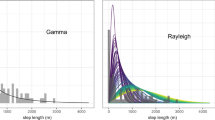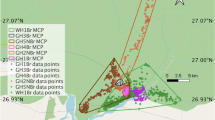Abstract
Movement plays a role in structuring the interactions between individuals, their environment, and other species. Although movement models coupled with empirical data are widely used to study animal distribution, they have seldom been used to study search time. This paper proposes first passage time as a novel approach for understanding the effect of the landscape on animal movement and search time. In the context of animal movement, first passage time is the time taken for an animal to reach a specified site for the first time. We synthesize current first passage time theory and derive a general first passage time equation for animal movement. This equation is related to the Fokker–Planck equation, which is used to describe the distribution of animals in the landscape. We illustrate the first passage time method by analyzing the effect of territorial behavior on the time required for a red fox to locate prey throughout its home range. Using first passage time to compute search times, we consider the effect of two different searching modes on a functional response. We show that random searching leads to a Holling type III functional response. First passage time analysis provides a new tool for studying how animal movement may influence ecological processes.
Similar content being viewed by others
References
Belisle, M., 2005. Measuring landscape connectivity: the challenge of behavioral landscape ecology. Ecology 86, 1988–1995.
Bell, W., 1991. Searching Behaviour. Animal Behaviour Series. Chapman and Hall, London.
Benichou, O., Coppey, M., Moreau, M., Suet, P.-H., Voituriez, R., 2005. Optimal search strategies for hidden targets. Phys. Rev. Lett. 94, 198101.
Berg, H., 1993. Random Walks in Biology. Princeton University Press, Princeton.
Burt, W., 1943. Territoriality and Home Range Concepts as Applied to Mammals. J. Mammal. 24, 346–352.
Condamine, S., Benichou, O., Tejedor, V., Voituriez, R., Klafter, J., 2007. First-pasage time in complex scale-invariant media. Nature 450, 77–80.
Dushek, O., Coombs, D., 2008. Analysis of serial engagement and peptide-MHC transport in T cell receptor microclusters. Biophys. J. 94, 3447–3460.
Fauchauld, P., Tveraa, R., 2003. Using first passage time in the analysis of area-restricted search and habitat selection. Ecology 84, 282–288.
Frair, J., Merrill, E., Visscher, D., Fortin, D., Beyer, H., Morales, J., 2005. Scales of movement by elk (Cervus elaphus) in response to heterogeneity in forage resources and predation risk. Landsc. Ecol. 20, 273–287.
Gardiner, C., 1985. Handbook of Stochastic Methods for Physics, Chemistry, and the Natural Sciences, 2nd edition. Springer, New York.
Grimm, V., 1999. Ten years of individual-based modelling in ecology: what have we learned and what could we learn in the future? Ecol. Model. 115, 129–148.
Gurney, W., Nisbet, R., 1998. Ecological Dynamics. Oxford University Press, London.
Holgate, P., 1971. Random walk models for animal behavior. In: Patil, G., Pielou, E., Waters, W. (Eds.), Statistical Ecology, vol. 2, pp. 1–12. Penn. State Univ. Press, University Park.
Holling, C., 1959. The components of predation as revealed by a study of small mammal predation of the European pine sawfly. Can. Entomol. 91.
Holmes, E., Lewis, M., Banks, J., Veit, R., 1994. Partial differential equations in ecology: spatial interactions and population dynamics. Ecology 75, 17–29.
James, A., 1999. Effects of Industrial Development on the Predator-Prey Relationship between Wolves and Caribou in Northeastern Alberta. Ph.D. thesis, University of Alberta.
Johnson, A., Wiens, B., Crist, T., 1992. Animal movements and population dynamics in heterogeneous landscapes. Landsc. Ecol. 7, 63–75.
Karlin, S., Taylor, H.M., 1998. An Introduction to Stochastic Modeling, 3rd edition. Academic Press, San Diego.
Lima, S., Zollner, P., 1996. Towards a behavioral ecology of ecological landscapes. TREE 11, 131–135.
McCauley, E., Wilson, W., Roos, A., 1993. Dynamics of age-structured and spatially structured predator-prey interactions: individual-based models and population-level formulations. Am. Natur. 142, 412–442.
Mech, D., Boitani, L., 2003. Wolves: behavior, ecology, and conservation. University of Chicago Press, Chicago.
Moorcroft, P., Lewis, M., 2006. Mechanistic Home Range Analysis. Princeton University Press, Princeton.
Moreau, M., Oshanin, G., Benichou, O., Coppey, M., 2003. Pascal principle for diffusion-controlled trapping reactions. Phys. Rev. E 67, 045104.
Moreau, M., Oshanin, G., Benichou, O., Coppey, M., 2004. Lattice theory of trapping reactions with mobile species. Phys. Rev. E 69, 046101.
Moreau, M., Benichou, O., Loverdo, C., Voituriez, R., 2007. Intermittent search processes in disordered medium. Europhys. Lett. 77, 234109.
Okubo, A., Levin, S., 2001. Diffusion and Ecological Problems. Springer, Berlin.
Ovaskainen, O., 2008. Analytical and numerical tools for diffusion-based movement models. Theor. Popul. Biol. 73, 198–211.
Redner, S., 2001. A Guide to First-Passage Processes. Cambridge University Press, Cambridge.
Redner, S., Krapivsky, P.L., 1999. Capture of the lamb: Diffusing predators seeking a diffusing prey. Am. J. Phys. 67, 1277–1283.
Schultz, C., Crone, E., 2001. Edge-mediated dispersal behavior in a prairie butterfly. Ecology 82, 1879–1892.
Siniff, D., Jessen, C., 1969. A simulation model of animal movement patterns. Adv. Ecol. Res. 6, 185–219.
Skellam, J., 1991. Random dispersal in theoretical populations. Bull. Math. Biol. 53, 135–165 (Reprinted from Biometrika 38, 196–218, 1953).
Solomon, M., 1949. The natural control of animal populations. J. Anim. Ecol. 18, 1–35.
Sovada, M.A., Sargeant, A.B., Grier, J.W., 1995. Differential effects of coyotes and red foxes on duck nest success. J. Wildl. Manag. 59, 1–9.
Turchin, P., 1991. Translating foraging movements in heterogeneous environments into the spatial distribution of foragers. Ecology 72, 1253–1266.
Turchin, P., 1998. Quantitative Analysis of Movement. Sinaur Associates, Inc. Publishers.
Weins, J., 2001. Dispersal, Chapter the Landscape Context of Dispersal, pp. 96–109. Oxford University Press, London.
Author information
Authors and Affiliations
Corresponding author
Rights and permissions
About this article
Cite this article
McKenzie, H.W., Lewis, M.A. & Merrill, E.H. First Passage Time Analysis of Animal Movement and Insights into the Functional Response. Bull. Math. Biol. 71, 107–129 (2009). https://doi.org/10.1007/s11538-008-9354-x
Received:
Accepted:
Published:
Issue Date:
DOI: https://doi.org/10.1007/s11538-008-9354-x




